Module 3 Body Language and Non-Verbal Communication
文档属性
| 名称 | Module 3 Body Language and Non-Verbal Communication |  | |
| 格式 | zip | ||
| 文件大小 | 2.2MB | ||
| 资源类型 | 教案 | ||
| 版本资源 | 外研版 | ||
| 科目 | 英语 | ||
| 更新时间 | 2012-05-25 13:54:31 | ||
图片预览

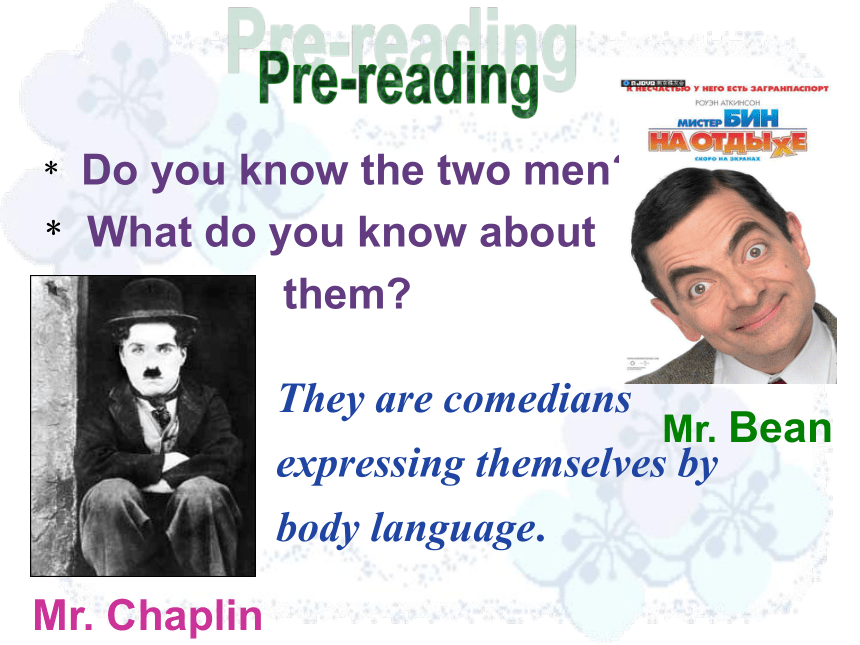

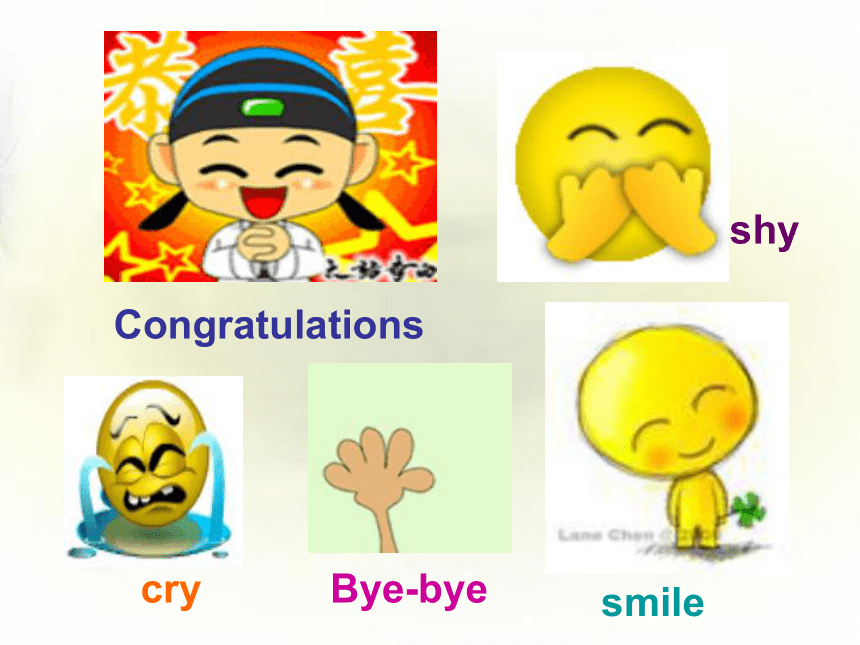
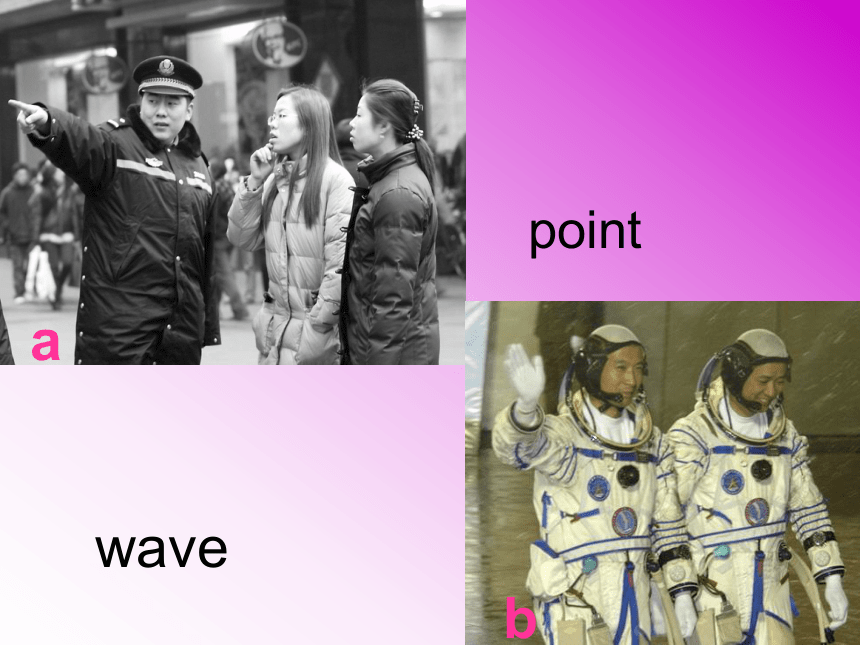
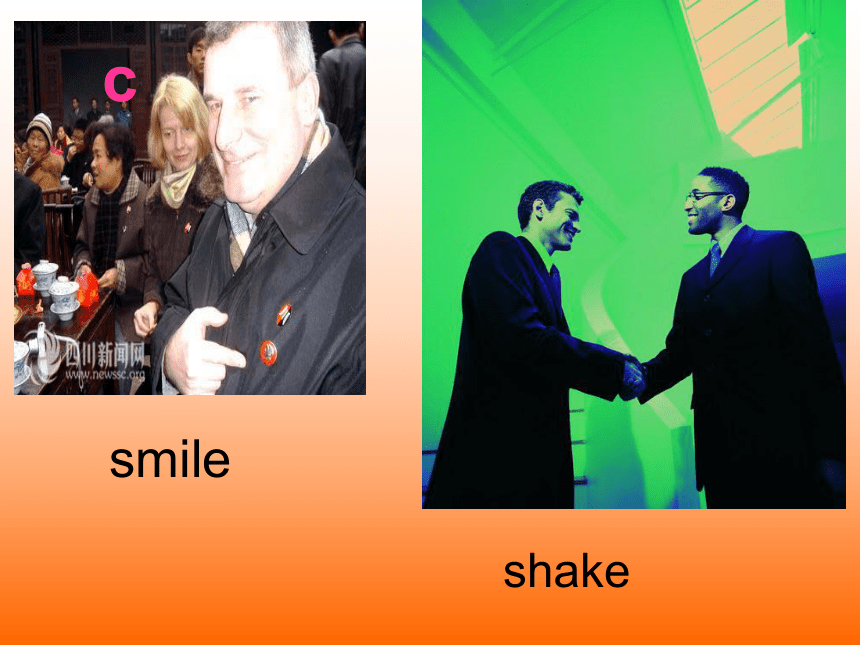
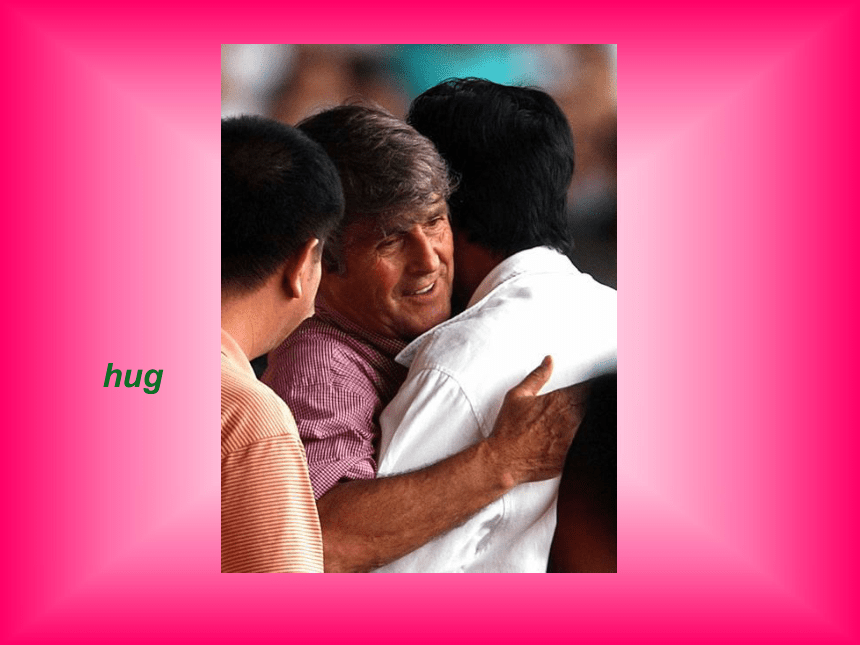
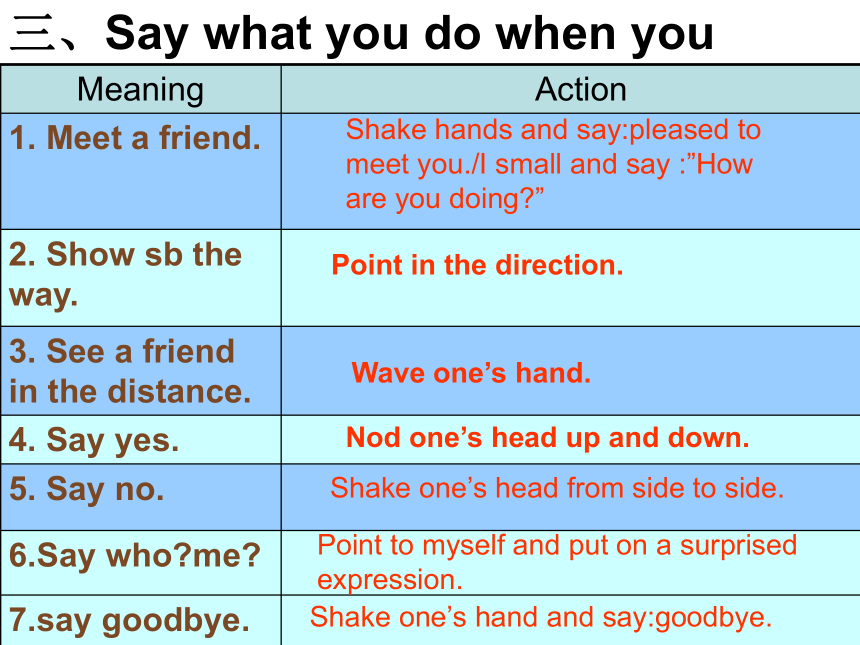
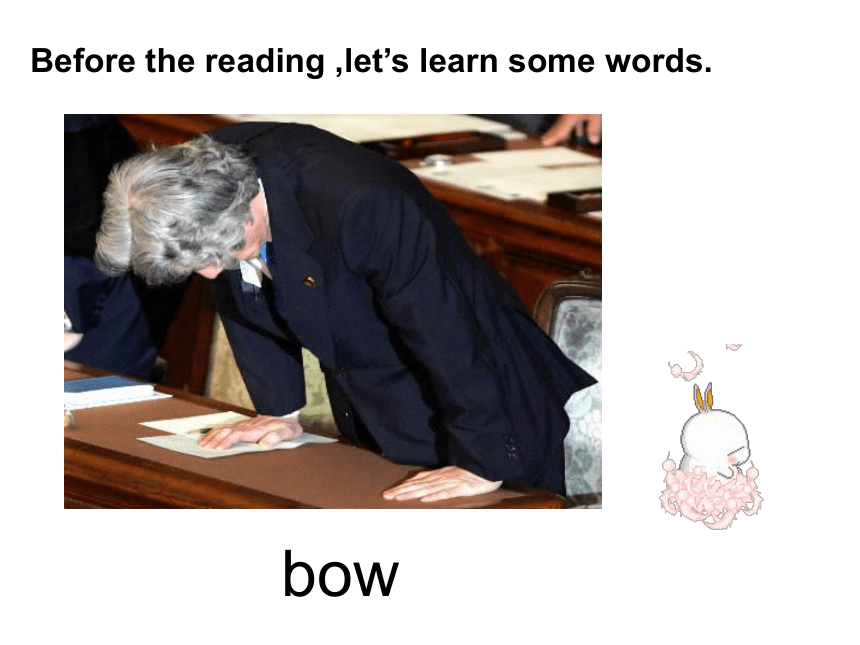
文档简介
(共28张PPT)
﹡ Do you know the two men
﹡ What do you know about
them
Mr. Bean
Mr. Chaplin
They are comedians expressing themselves by body language.
In our life ,we often use the body lang-uage, it is a way of our communication. Look at the pictures below.
Shake hands
victory
ok
stop
Great!
Congratulations
smile
shy
cry
Bye-bye
point
wave
a
b
smile
c
shake
hug
三、Say what you do when you
Meaning Action
1. Meet a friend.
2. Show sb the way.
3. See a friend in the distance.
4. Say yes.
5. Say no.
6.Say who me
7.say goodbye.
Shake hands and say:pleased to meet you./I small and say :”How are you doing ”
Point in the direction.
Wave one’s hand.
Nod one’s head up and down.
n
Shake one’s head from side to side.
Point to myself and put on a surprised expression.
Shake one’s hand and say:goodbye.
Before the reading ,let’s learn some words.
bow
clap
slap
high five
weapon
Muslim
Hindu
Read the text quickly and choose the best title.
1 Saying It Without Words
2 When in Rome, Do as the Romans
Do
3 Greeting Around the World
4 Read My Mind
Match the general idea with each paragraph.
Para1 greetings in Asian countries
Para2 ways of communication
Para3 fascinating body language
Para4 Body language is fascinating
for us to study
Para5 American youth’s greeting today
Ⅰ. Read the passage carefully and say if these statements are true or false,and correct it.
1. Not all body language is conscious.
2. Europeans shake hands with their left hand.
3. In Asia, people touch strangers when they meet.
4. In the US a “high five” is a way of saying hello.
5. A “high five” is a formal gesture.
6. Body language is less communicative than spoken or written language.
Ⅱ.Complete the table.
Europeans, Americans
China
Muslims
shake hands
the right hand
I trust you…
put the right hand over the left and bow slightly
the hands
show respect
salaam
heart,mouth,forehead
respect
Countries or areas The way of greeting The parts of body involved The meaning of the greeting
Countries or areas The way of greeting The parts of body involved The meaning of the greeting
Join their hands and bow their heads
the hands ,
head
respect
The hand
say hello
A “high five”
Hindus
American youths
Let’s imitate the ways of greeting of the different people,such as Eurpeans, Chinese,Muslims,Hindus, American youths.
Guess the pictures
below.
Hindus
American youths
Chinese
★Guess the meaning of the words given and complete the sentences below.
aggressive, deal, gesture, greet, formal, informal position, trust , unconscious, weapon
Guns and knives are two different types of .
Someone who has a(n) attitude may be violent.
You can someone by saying “Hello”.
weapons
aggressive
greet
aggressive, deal, gesture, greet, formal, informal , position, trust , unconscious, weapon
4.Your is the way you are sitting or standing.
5.If you are of something you do not know it is happening.
position
unconscious
6. A(n) is a business agreement.
deal
7. A(n) is a movement of the body
to communicate something.
gesture
aggressive, deal, gesture, greet, formal, informal , position, trust , unconscious, weapon
8. If you someone you believe them and rely on them.
9. “Give me five!” is a(n) greeting.
10. People are usually more with people they don’t know.
trust
informal
formal
Ways of communication
Spoken language
Written language
Body language
gesture
feelings
writing
typing
talking
phoning
①
②
③
④
⑤
⑥
⑤
⑥
①
②
③
④
七、Read the text and then retell the text
Three times:
The first time: easy
The second time: a little difficult
The last time: more difficult
The first time
If you say the word______,most people think of___and ___.Although these are very____,we communicate with____just___and____words.Indeed,____are part of_____very often,_____there is also _______body language,_______from _____to____.
The second time
We use__________when___.Traditionally,Europeans and Americans_____.They do this with_______--_______.So the gesture is saying,”___________
.It means,”________.”
Greetings in Asian countries do not ______,but_____hands.
Even today ,when some people have very ____________,they still use________.
Find out more ways of greeting in the different cultures.
Complete the exercises related to Vocabulary and Reading in the Workbook on page 80—82.
﹡ Do you know the two men
﹡ What do you know about
them
Mr. Bean
Mr. Chaplin
They are comedians expressing themselves by body language.
In our life ,we often use the body lang-uage, it is a way of our communication. Look at the pictures below.
Shake hands
victory
ok
stop
Great!
Congratulations
smile
shy
cry
Bye-bye
point
wave
a
b
smile
c
shake
hug
三、Say what you do when you
Meaning Action
1. Meet a friend.
2. Show sb the way.
3. See a friend in the distance.
4. Say yes.
5. Say no.
6.Say who me
7.say goodbye.
Shake hands and say:pleased to meet you./I small and say :”How are you doing ”
Point in the direction.
Wave one’s hand.
Nod one’s head up and down.
n
Shake one’s head from side to side.
Point to myself and put on a surprised expression.
Shake one’s hand and say:goodbye.
Before the reading ,let’s learn some words.
bow
clap
slap
high five
weapon
Muslim
Hindu
Read the text quickly and choose the best title.
1 Saying It Without Words
2 When in Rome, Do as the Romans
Do
3 Greeting Around the World
4 Read My Mind
Match the general idea with each paragraph.
Para1 greetings in Asian countries
Para2 ways of communication
Para3 fascinating body language
Para4 Body language is fascinating
for us to study
Para5 American youth’s greeting today
Ⅰ. Read the passage carefully and say if these statements are true or false,and correct it.
1. Not all body language is conscious.
2. Europeans shake hands with their left hand.
3. In Asia, people touch strangers when they meet.
4. In the US a “high five” is a way of saying hello.
5. A “high five” is a formal gesture.
6. Body language is less communicative than spoken or written language.
Ⅱ.Complete the table.
Europeans, Americans
China
Muslims
shake hands
the right hand
I trust you…
put the right hand over the left and bow slightly
the hands
show respect
salaam
heart,mouth,forehead
respect
Countries or areas The way of greeting The parts of body involved The meaning of the greeting
Countries or areas The way of greeting The parts of body involved The meaning of the greeting
Join their hands and bow their heads
the hands ,
head
respect
The hand
say hello
A “high five”
Hindus
American youths
Let’s imitate the ways of greeting of the different people,such as Eurpeans, Chinese,Muslims,Hindus, American youths.
Guess the pictures
below.
Hindus
American youths
Chinese
★Guess the meaning of the words given and complete the sentences below.
aggressive, deal, gesture, greet, formal, informal position, trust , unconscious, weapon
Guns and knives are two different types of .
Someone who has a(n) attitude may be violent.
You can someone by saying “Hello”.
weapons
aggressive
greet
aggressive, deal, gesture, greet, formal, informal , position, trust , unconscious, weapon
4.Your is the way you are sitting or standing.
5.If you are of something you do not know it is happening.
position
unconscious
6. A(n) is a business agreement.
deal
7. A(n) is a movement of the body
to communicate something.
gesture
aggressive, deal, gesture, greet, formal, informal , position, trust , unconscious, weapon
8. If you someone you believe them and rely on them.
9. “Give me five!” is a(n) greeting.
10. People are usually more with people they don’t know.
trust
informal
formal
Ways of communication
Spoken language
Written language
Body language
gesture
feelings
writing
typing
talking
phoning
①
②
③
④
⑤
⑥
⑤
⑥
①
②
③
④
七、Read the text and then retell the text
Three times:
The first time: easy
The second time: a little difficult
The last time: more difficult
The first time
If you say the word______,most people think of___and ___.Although these are very____,we communicate with____just___and____words.Indeed,____are part of_____very often,_____there is also _______body language,_______from _____to____.
The second time
We use__________when___.Traditionally,Europeans and Americans_____.They do this with_______--_______.So the gesture is saying,”___________
.It means,”________.”
Greetings in Asian countries do not ______,but_____hands.
Even today ,when some people have very ____________,they still use________.
Find out more ways of greeting in the different cultures.
Complete the exercises related to Vocabulary and Reading in the Workbook on page 80—82.
